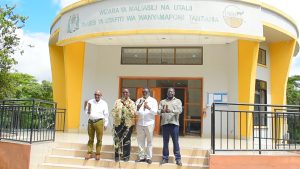The assessment of vegetation and habitat dynamics is crucial to provide information on vegetation and habitat resources for integration into management plans for tourism improvements within and around the priority protected areas (PAs) of the REGROW project. So far, the project has contributed critical information for the improvement of resource management for sustainable tourism on wildlife corridors using the Nyerere National Park and Wami-Mbiki Game Reserve wildlife corridor as a case study. The project has produced a policy brief document that contributes to policy dialogue on wildlife corridors in Tanzania. In this policy brief, issues such as Anthropogenic disturbances, Lack of updated Village Land Use Plans (LUP), un-demarcated corridors exacerbating human-wildlife conflicts, lack of an Integrated Corridors Management Programme (ICMP), and Lack of detailed information about corridors were discussed as critical issues influencing corridor conservation. The policy related recommendations include among others the need to develop a policy implementation strategy and guidelines that take into account the current operational gaps in the management of wildlife corridors in Tanzania, such as involving dialogue with communities; to facilitate the development of Village LUP and the accomplishment of corridors demarcation processes and gazettement to enhance effective protection, management and reduce human-wildlife conflicts, to facilitate establishment and implementation of an integrated Corridors Management Programme (ICMP) in order to promote effective cooperation among responsible institutions, Institute an M&E framework and a functional database under the MNRT as a tool for decision making. The project documents plant resources for Mikumi National Park which are more than 770 species records including 35 species which are listed under the IUCN as species of concern. Such information draws insights into the importance of vegetation surveys for Mikumi NP and other protected areas (PAs). It emphasises the need to update the floral database of protected areas across Tanzania which are large of the old Taxonomic nomenclature. The understanding will help suggest and implement feasible management techniques and contribute to the spatial knowledge of species of conservation value, attracting tourism and investment in scientific research and, at a larger level, fulfilling the global requirements of the Aichi Biodiversity Targets. In Nyerere National Park, Tanzania a total number of 272 plant species that are readily available as forage for wildlife during stress periods, especially dry seasons were documented.
- Category : Regrow PRoject
- Posted on: August 15, 2023






 Users Today : 67
Users Today : 67 Users Last 7 days : 653
Users Last 7 days : 653 Users This Month : 1371
Users This Month : 1371 Total Users : 55906
Total Users : 55906